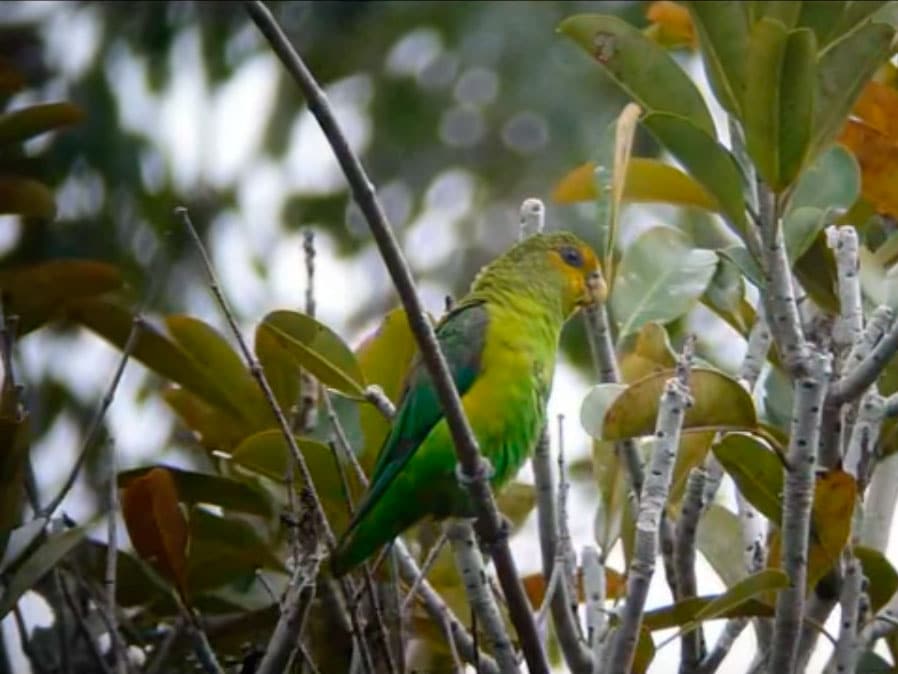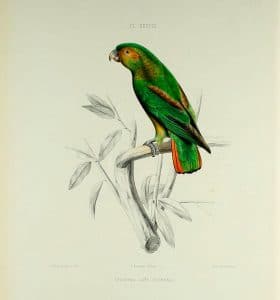Content |
|---|
Description:
16 cm.. length.
The Golden-tailed Parrotlet (Touit surdus) has a plumage mostly green; the forecrown, lores, supercilii area and cheeks, They are yellowed; crown, rear area of the neck, ear-coverts and sides neck, green with dark narrow margins, giving a scaly appearance.
Mantle and back, green with rump and uppertail-coverts slightly brighter, more emerald. Scapulars and inner tertials, warm brown: primary coverts, dark brown, rest of the coverts green. The the flight feathers They are brown above with narrow green margins to outerweb; brown opaque below. Blue feathers Carpal edge of the wing. Underwing-coverts green. Chin yellowish; chest brighter yellowish green, brighter in the belly and in the undertail-coverts. Tail, centrally green with faint black markings at tips, laterally golden-yellow with narrow black tips on upper surface.. The bill yellow horn; gray irises, legs grey.
The female perhaps duller below, with lateral feathers tail greener and green tips and margins. Immature not described.
- Sound of the Golden-tailed Parrotlet.
Description 2 subspecies:
The subspecies Touit surdus chryseurus it has been proposed to birds of northeastern range on the basis of dubious lateral tail feathers more brownish and smaller.
-
Touit surdus chryseurus
(Swainson, 1823) – Side tail feathers, brown / yellow; smaller.
-
Touit surdus surdus
(Kuhl, 1820) – Nominal.
Habitat:
They live mainly in evergreen forests lowland, although occasionally they extend to the adjacent lower mountain slopes. Birds have been observed in the canopy of a secondary forest fragment surrounded by open fields; Other reports suggest that birds visit fruiting trees in deforested areas to feed.
You can visit, occasionally, cocoa plantations where trees shade the crop plants, but this has not been tested. They are to 700 m in Alagoas and to 800 m in Espirito Santo, Rio de Janeiro and São Paulo. The Brown-backed Parrotlet They seem to live in flocks (mainly 6-12), perhaps you composed of family groups.
Recent observations suggest that this species is resistant habitat alteration.
Reproduction:
The reproduction of this species practically is not registered. A female observed in September Alagoas, He was not in breeding condition.
Food:
Foods reported in feed Brown-backed Parrotlet are fruits Spondias lutea and Rapanea schwackeana
Distribution:
Size of its range (breeding/resident ): 1.680.000 km2
The distribution of the Brown-backed Parrotlet It extends through Atlantic forests of eastern Brazil, including coastal areas of the northeastern states of Paraíba, Pernambuco and Alagoas with a record Camocim in the North of Ceará, where there are fragments of humid forest in coastal areas.
Exist sporadic records but widespread (mainly) on the shores of Bay and Espirito Santo, and in Rio de Janeiro, for example in Teresopolis, around the Itatiaia National Park, new Freiburg and Cabo Frio, with some reports São Paulo southwest to Cardoso Island, near the border with Paraná. The reports of For and Goiás They are not substantiated and they are probably wrong. The apparent seasonal distribution of the species in some areas suggests migration trends.
They seem to be distributed at low densities and (except a report in the lower basin tiete river in Sao Paulo) It was considered a rare species in the nineteenth century. Like other members of the genus is, without a doubt, ave a difficult to observe, and often overlooked. But, many ancient villages are no longer inhabited, with forests completely eliminated or severely degraded lowland, especially in the north of the mountain range, where you can be almost extinct. In the news They are distributed in several protected areas.
Distribution 2 subspecies:
-
Touit surdus chryseurus
(Swainson, 1823) – Northwest of Brazil, Paraiba, Pernambuco and Alagoas.
-
Touit surdus surdus
(Kuhl, 1820) – Nominal. Southeast of Brazil, from the South of Bay and possibly southern Goiás, south to São Paulo.
Conservation:
State of conservation ⓘ |
||
|---|---|---|
 Vulnerable ⓘ (UICN)ⓘ
Vulnerable ⓘ (UICN)ⓘ
| ||
• Current category of the Red List of the UICN: Vulnerable.
• Population trend: Decreasing.
Population size: 2500-9999 specimens.
Rationale for the Red List category
This species is classified as Vulnerable because its population is small and declining rapidly due to continuous deforestation. It has been found that it is more resistant to forest fragmentation of what was thought first, and may be sub-registered instead of actually little, especially in the southern part of its range.
Justification of the population
The species is generally rare; Its population is located in the band 2.500-9.999 mature individuals, equivalent to 3.750-14.999 individuals, rounded here to 3.500-15.000 individuals.
Justification of trend
rapid and continuous population decline is suspected on the basis of continuous destruction and fragmentation of habitat.
"Golden-tailed Parrotlet" in captivity:
Rare and unknown in captivity. Any captive individual (it can not be released) It should be part of a conservation program well managed to ensure continuity of this species.
Alternative names:
– Golden-tailed Parrotlet, Golden tailed Parrotlet (English).
– Toui à queue d’or (French).
– Gelbschwanzpapagei, Gelbschwanz-Papagei (German).
– Apuim-de-cauda-amarela, papagainho, periquitinho, periquitinho-surdo (Portuguese).
– Cotorrita Sorda, Lorito de Cola Dorada (español).
scientific classification:

– Order: Psittaciformes
– Family: Psittacidae
– Genus: Touit
– Scientific name: Touit surdus
– Citation: (Kuhl, 1820)
– Protonimo: parrot deaf
Images Golden-tailed Parrotlet:
Videos of the "Golden-tailed Parrotlet"
Golden-tailed Parrotlet (Touit surdus)
Sources:
- Avibase
- Parrots of the World – Forshaw Joseph M
- Parrots A Guide to the Parrots of the World – Tony Juniper & Mike Parr
- Birdlife
- parrots.org
-
Photos:
(1) – Golden-tailed Parrotlet – Touit surdus – Golden-tailed parrotlet by Ciro Albano
youtube.com/watch?v = ZaWxtXYx6U
(2) – Urochroma deaf By Blanchard, Emile; Bonaparte, Charles Lucian; Bourjot Saint-Hilaire, Alexandre; Le Vaillant, François; Souancé, Charles de. [CC BY 2.0 or Public domain], via Wikimedia Commons
- Sounds: Leonardo Patrial (Xeno-canto)


